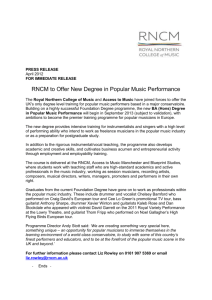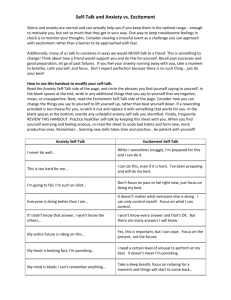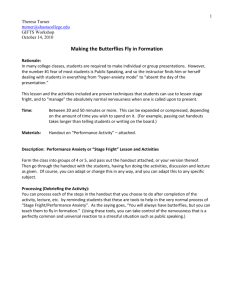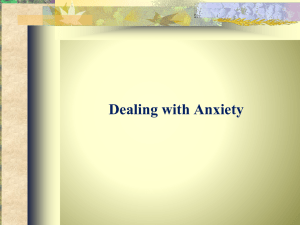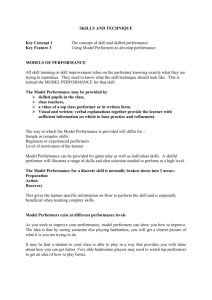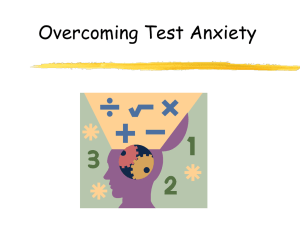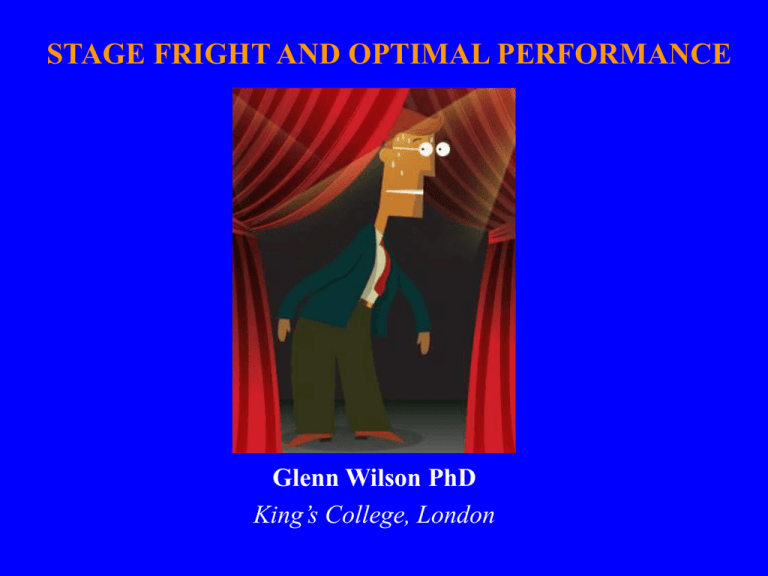
STAGE FRIGHT AND OPTIMAL PERFORMANCE
Glenn Wilson PhD
King’s College, London
WHAT IS STAGE FRIGHT?
•
•
•
•
An exaggerated fear of public appearance
Not correlated with talent or ability
Like other phobias, not amenable to reason
Strikes experienced professionals as well as
novices
SYMPTOMS
General fight/flight (adrenaline) reaction:
• Sweating/trembling
• Raised HR/BP/palpitations
• Dry mouth/difficulty swallowing
• Shortness of breath/dizziness
• Butterflies in the stomach/nausea
• Blurred vision
• Loss of concentration/memory
Would have survival value if fighting or running
from audience were appropriate.
PREVALENCE
University of Iowa School of Music survey
(302 students/faculty):
21% “marked distress”
40% “moderate distress”
17% “marked impairment”
30% “moderate impairment”
9% “often avoided performance opportunities”
13% “interrupted a performance at least once”
15% “sought professional help”
MUSICIANS SUFFER MOST
Marchant-Haycox & Wilson (1992):
Musicians 47%
Singers 38%
Dancers 35%
Actors 33%
Requirements of musical
performancemore exacting
than acting?
Solos worse than group performances (anxiety diminishes
logarithmically with number of fellow performers).
Auditions & competitions worse than opening nights.
STAGE FRIGHT IS NOT ALWAYS BAD
De Vries (1999) found that actors were more likely to
report that stage fright facilitated their performance rather
than interfere with it.
YERKES-DODSON LAW
Performance improves with increasing arousal up to an optimum
point, beyond which it becomes detrimental.
TASK COMPLEXITY
The optimal point is reached more rapidly when the task is cognitively
complex (needing a clear head rather than just energy expenditure).
The best musical performances (objectively assessed) occur at a level of
arousal that is felt as uncomfortable to the performer themselves.
A three-dimensional extension of the Yerkes-Dodson Law.
Optimal performance depends on interplay of individual differences,
situational stress, and task mastery.
CATASTROPHE THEORY
Hardy & Parfitt (1991) argue that a catastrophe model fits best. Once
anxiety goes “over the top” there is a precipitous downturn with little
chance of retrieval. Most likely to occur when cognitive anxiety is
high as well as body agitation.
COGNITIVE STRATEGIES
Catastrophe theory fits research on
destructive thinking (Steptoe & Fidler 1987).
Most detrimental - catastrophising:
“I think I am going to faint”
“I’m sure to make a dreadful mistake and that will ruin
everything”
Best kind - realistic appraisal:
“I’m bound to make a few mistakes, but so does everyone.”
“The audience wants me to play well and will make allowance
for a few slips”.
DRUGS
• Anxiolytics (alcohol, benzodiazapines, cannabis):
Often used as self-treatment. Diminish
performance. Addictive & ultimately destructive.
• Stimulants (caffeine, amphetamine, cocaine):
Again self-treatment – to stay awake, give energy
& inspiration (esp. jazz musicians). Also addictive
& destructive.
• Beta-blockers (nadolol, oxprenolol):
Supposed to control physical symptoms of fear
without cognitive impairment.
Used by many musicians,
often without prescription .
Efficacy unclear &
side-effects serious.
EXERCISE AND SLEEP
• Physical activity is an effective antidote against
anxiety & depression. Fitness
promotes stress resistance.
• Exposure to blue sky and fresh air
also beneficial (esp. in winter).
• Important to take regular breaks
during practice/rehearsal to
avoid “cluttering”.
• Sleep equally important - consolidates new
learning. Late nights & drinking impair
concentration.
• Snooze before performance usually better than
last-minute rehearsal.
SYSTEMATIC DESENSITISATION
• Classic behaviour therapy approach to phobias.
• Begins with training in muscle relaxation
(possibly including biofeedback).
• Feared scenarios then introduced in graded doses
(first in imagination, then reality).
• Theory is to break the fear>escape habit,
persuading performer to maintain exposure
until fear extinguishes.
• Some success, esp. with speech anxiety, but does
not account for continuing fear in seasoned
performers.
BREATHING RETRAINING
Hyperventilation is common among high anxious
performers (esp. female, c.f. panic disorders).
Overly fast & deep breathing, surplus to
requirements, leads (paradoxically) to O2
deprivation in brain; hence dizziness, loss of
concentration, etc.
Applies particularly to singers & wind-players.
Learning to breathe slowly, esp. in expiration phase,
an important component of relaxation training.
ATTENTION ALLOCATION
Focus of attention may be allocated three ways:
The self: How am I looking? Am I playing well?
The audience: How are they reacting? Are they
impressed or showing signs of boredom/dislike?
The music: Absorption in technical intricacies,
shape, emotions it evokes.
Absorption in the work is associated with least
anxiety and optimal performance. Cognitive
therapy aims at redirecting attention toward
artistic flow of the work.
RATIONALIZING THOUGHT
Performance often disrupted by irrational, negative thoughts:
Overgeneralization: “I never…” “I always…”
All-or-nothing thinking: “I am either a star or a loser.”
Disqualifying the positive: “They liked my performance,
but what do they know?”
Self-reference: “Whatever is said about my performance is
about me”.
Superstition: “Without my pre-performance ritual I can’t
perform well.”
Catastrophising: “Once I make a mistake I’ll never get
back on track.”
Cognitive therapy seeks to identify these destructive
thoughts and replace them with positive ones.
STRESS INOCULATION
Developing realistic expectations can be as useful as
positive affirmations.
Performers taught to anticipate adrenalin effects but
“befriend” them (reframe them as less threatening,
even desirable).
Pointed out that:
(a) they are seldom conspicuous to the audience.
(b) if noticed are seen as artistic emotionality.
(b) contribute “electricity” to
performance.
(c) similar to what is felt
if running to catch a bus or having
sex (excitement rather than fear).
SELF-HANDICAPPING
Hedging bets - a potentially harmful
strategy adopted by some performers:
“I have a sore throat at the moment”
“I’ve never seen this music before”
“My teacher demands an interpretation that doesn’t suit me”
“I would have done better if I hadn’t had a late night.”
Such negative self-talk easily becomes self-fulfilling prophecy.
Next step is self-sabotage: e.g., failing to attend rehearsals;
damaging one’s own instrument; getting drunk before a
performance.
Susceptible individuals need to watch for signs in themselves
and insert positive strategies.
PICTURE IT PERFECT
Instead of positive self-talk, some performers
find it helpful to visualize ideal
accomplishment (e.g., imagining
themselves as Margot Fonteyn at
Covent Garden or Pavarotti at La Scala.
Most useful when performance is visual
(e.g. sports skills, dance).
Fantasies mimic effects of stage hypnosis,
where ordinary members of the public
give impressive performances.
Mental rehearsal, when optimistic and
goal-oriented, can optimise performance
in many arenas.
CHECKLIST
• Is your tension really detrimental? (It might focus your
thoughts; add a spark.)
• Is it telling you something useful? (Work too difficult?;
more preparation needed?)
• Clean up your act. Don’t depend on drugs. Get more
exercise/sleep.
• Is hyperventilation involved? Learn slow-breathing.
• Conditioned fear? Cognitive-behaviour therapy might
help.
• Self-obsessed? Focus on enjoyment of the work rather
than audience evaluation.
• Negative, catastrophizing self-talk? Replace with positive
goal-imaging.
BIBLIOGRAPHY
Full details and references may be found in:
G.D.Wilson: Psychology for Performing
Artists (Second Edition). London, Wiley
(2002).

